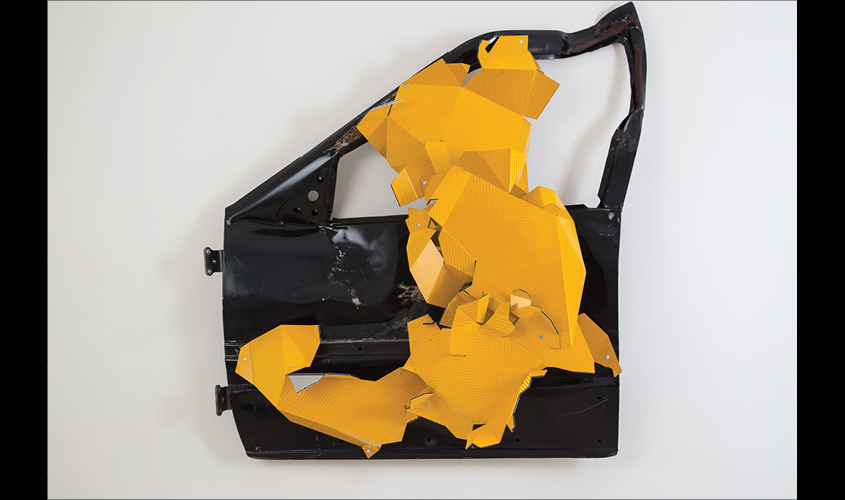Can the rubbish heap be seen as a subject fit for art? Two new exhibitions, currently on at separate venues in Delhi and Mumbai, explore that question with a series of photographs and installation pieces on the theme of waste, writes Bhumika Popli.
In two distinct exhibitions, on view now in Delhi and Mumbai, artists have literally found their inspiration in waste.
The exhibition titled Wasteland, at Mumbai’s Tarq gallery, features a range of mixed-media works. Here, seven contemporary artists have set up 27 artworks in total, all composed of assorted waste material. Items like nails, copper wires, polythene bags and cigarette butts have been used in these installation pieces.
The other exhibition on a similar theme, entitled The City of Waste, is on at Delhi’s Mandi House Metro Station. This exhibition is a part of Habitat Photosphere, India Habitat Centre’s year-long photography festival on sustainable development. Images by six French photographers, featuring waste workers from various parts of the world, are the focus of this show.
Wasteland is organised as part of a public diplomacy campaign, called “70 Years of Swiss-Indian Friendship”. Guardian 20 speaks to the show’s curator Birgid Uccia, who tells us about her engagement with this particular show. “I was interested in the fact that large parts of society still consider waste as impure, evoking disgust and repression,” she says. “By contrast, the artists in the show address waste as a phenomenon that holds collective memory and personal stories. We realise that waste is not anonymous, but tells us about the cultural practices of a society, the behaviour of individuals, the demographics, the means of production and trends of consumption.”

Delhi-based artist Asim Waqif is among those who have contributed their work to Wasteland. His artwork, Collapse Analysis Of Concrete Slabs Due To Aerial Bombardment, presents the fate of a discarded vehicle in a war-torn area. He says, “For a long time I have been looking at the creative potential of decay and dereliction. For this particular one, I was trying to look at the propagation of images of destruction circulated in the media, which looks like a mechanism of projecting a sort of political statement. In my work, the way the yellow part is placed on the car door is based on a picture of a building in Syria, which was bombed several times. Through the vector drawing, I am trying to do an architecture analysis of the destroyed building.”
Prashant Pandey, another artist in the show, only works with waste products as his material. For his disc-shaped sculpture, Universe, he used cigarette butts to metaphorically define human emotions. He says, “Through the cigarette butts used here, I have tried to understand varied human feelings ranging from being used, left, loved, hated and so on.”
Aaditi Joshi’s choice of medium in this exhibition is plastic. For this show, she has created a large-scale site-specific work, which spirals through two floors of the gallery. She has used clusters of plastic bags which are painted in various colours. She says, “I am interested in the fluidity of plastic, and I am quite aware of the environmental hazards caused by this material. Hence, I see myself exploring the idea of plastic as ‘object of trash’ and an ‘object of beauty’.”
The City of Waste in Delhi is part of a larger project, called “Urban Societies and Waste”, organised by French photographers Rémi de Bercegol and Christine Ithurbide. “The different photographs of waste workers here will strike one for the similarities between situations taken from various parts of the world,” says Rémi de Bercegol. “No matter how different the city is, the workers appear similar. As do their tools, poses and overall landscapes. In numerous cities, you’ll indeed find the same kind of ‘city of waste’, working in parallel to the conventional city.

These photographs give an insight into the lives of waste-pickers across the world. He says, “Waste-picking is by no means a recent phenomenon and is common in numerous cities, with waste-pickers in search of materials that they can resell, repair, reuse or recycle—be it the biffins in Paris, the cartoneros in Argentina, the catadores in Brazil, the pepenadores in Mexico, the kabaadi waala in India, the dongnat in Vietnam. All these men, women and sometimes children, are pushed out to the fringes of the labour market and often live in the margins of society. They make a living from city dwellers’ refuse. With the work they do to extract a variety of materials, these waste workers earn a generally modest living and provide a real service to the city and its inhabitants, doing away with a part of their waste.”
He adds, “The idea was to document and picture this world of waste workers, living in the same city like you and me, but, unlike us, constrained to marginality because of the stigma attached to waste. These photographs are thus shedding some light on the people of ‘the city of waste’, which is part of the shining metropolis.”
‘Wasteland’ is on view at Mumbai’s Tarq gallery till 4 August; ‘The City of Waste’ is on view at Delhi’s Mandi House Metro Station till 30 June

